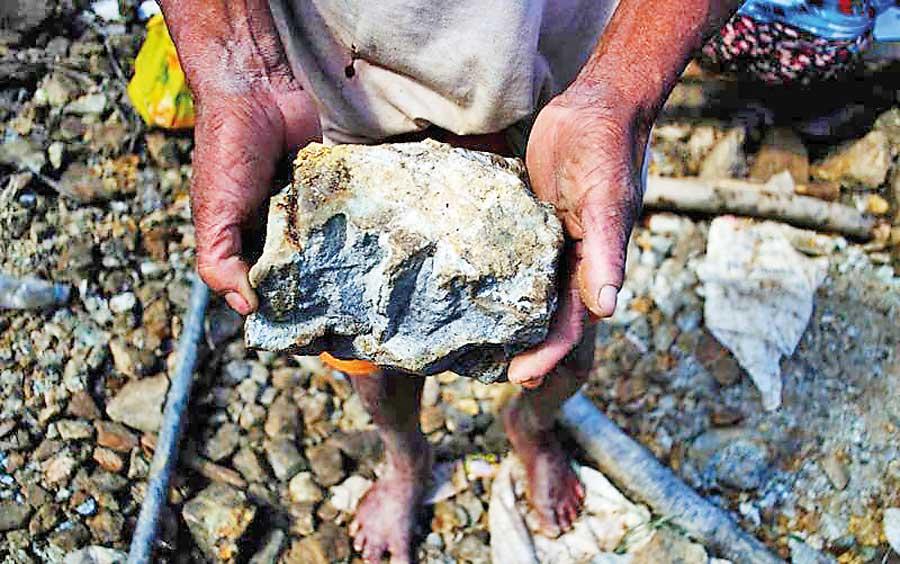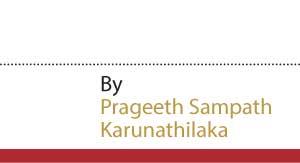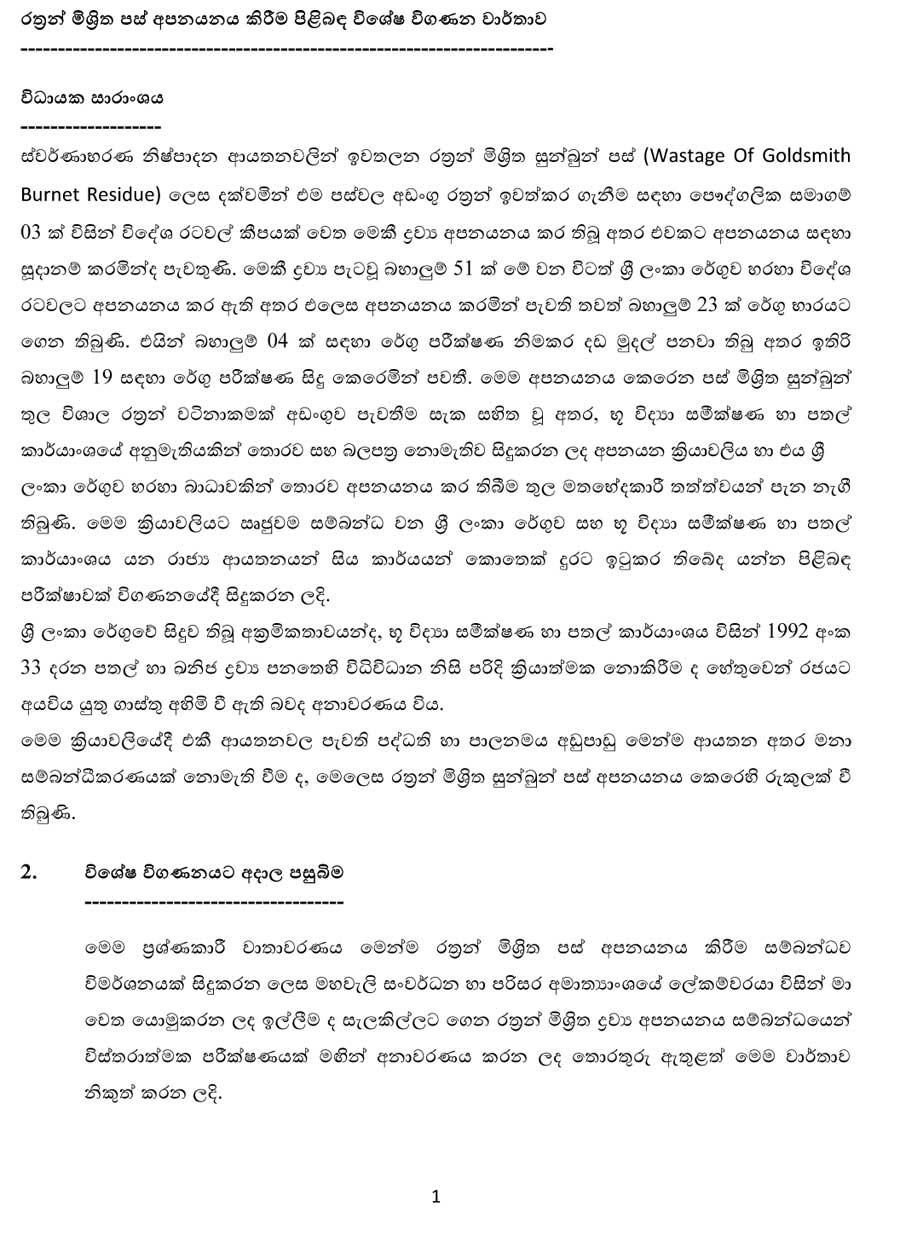02 Jan 2023 - {{hitsCtrl.values.hits}}

A picture taken at a Seruwila copper and iron deposit
Geological Survey and Mines Bureau (GSMB) receives 7% as royalty in mineral exploration. This royalty should be paid to the Department of Treasury. But a spokesperson of the GSMB confirmed that the seven percent royalty is not transmitted to the Treasury. He also said that the amount received as the royalty is used to pay salaries and bonuses and, in some cases, to throw parties. In that manner, a large amount of money due to the Government is misused. These parties are held in the guise of official duties or in the pretext of conducting religious programmes.
paid to the Department of Treasury. But a spokesperson of the GSMB confirmed that the seven percent royalty is not transmitted to the Treasury. He also said that the amount received as the royalty is used to pay salaries and bonuses and, in some cases, to throw parties. In that manner, a large amount of money due to the Government is misused. These parties are held in the guise of official duties or in the pretext of conducting religious programmes.
According to an audit report the GSMB must properly transmit the royalty to the Government. For the Yan Oya project, the relevant construction company still needs to pay the royalty for 1,343,810 cubic metres of earth and 3397 cubic meters of sand. Per the 2019 Audit Report, royalties amounting to 26,876,200 rupees and 5433490 rupees, and 27,419,690 rupees for soil and sand have yet to be recovered. The report also says that the royalty charged for graphite in 2016, 2017, and 2018 was 65 percent less than the approved royalty mentioned in the mining licenses, i.e., 1,427,174,239.00 rupees. According to the audit report, the GSMB has stated that legal measures have been taken regarding the deduced royalty charged for granite.
 The GSMB spokesperson drew this newspaper’s attention to an act involving partying. Accordingly, several GSMB officials who had visited Yan Oya around September 2018 for a survey and inspection had attended an evening puja (ritual) after spending some time there. They had been instructed to bring white garments; a hint that they would be visiting a temple. “Around 75 people including geologists and engineers participated in this ritual. Food and accommodation facilities, as well as vehicles of the bureau, were provided to them. The entire cost of this programme, which lasted for two days, was covered by the money received as the royalty. They enjoy their time staying at a hotel belonging to either a sand miner or quarry owner; making claims that these events are progress meetings or other meetings. The best example was the progress meeting held at a hotel near Unawatuna. It was in a hotel belonging to a quarry owner. The meeting didn’t last even 10 minutes. Then they began enjoying themselves spending the money received as royalty.” he added.
The GSMB spokesperson drew this newspaper’s attention to an act involving partying. Accordingly, several GSMB officials who had visited Yan Oya around September 2018 for a survey and inspection had attended an evening puja (ritual) after spending some time there. They had been instructed to bring white garments; a hint that they would be visiting a temple. “Around 75 people including geologists and engineers participated in this ritual. Food and accommodation facilities, as well as vehicles of the bureau, were provided to them. The entire cost of this programme, which lasted for two days, was covered by the money received as the royalty. They enjoy their time staying at a hotel belonging to either a sand miner or quarry owner; making claims that these events are progress meetings or other meetings. The best example was the progress meeting held at a hotel near Unawatuna. It was in a hotel belonging to a quarry owner. The meeting didn’t last even 10 minutes. Then they began enjoying themselves spending the money received as royalty.” he added.
The spokesman also said that mineral mining is carried out without the environmental study reports by selling the mining licenses issued by the bureau. “The redrock ilmenite deposit in Pulmude was mined sans any environmental report. This mining operation was halted after the media exposed the matter,” the spokesperson said.
“The money to pay these bonuses is obtained from the inspection fees charged when issuing mining permits. The GSMB officials do not go to inspect the projects, and therefore the money is saved. Now the inspection fees have been increased”
- GSMB Spokesperson
The royalty is an income the country needs and should be adequately utilised and charged correctly. The best example is Port City. Around 80 million rupees is to be charged as royalty. But according to the 2016 Audit Report, the royalty is yet to be obtained, the spokesperson said.
The GSMB pays four to five bonuses a year, amounting to one and a half times the salary payable. That’s a lot of
|
An extract from a COPE report relating to the salaries and other payments made to Geological Survey and Mines Bureau officials |
money. “The money to pay these bonuses is obtained from the inspection fees charged when issuing mining permits. The GSMB officials do not go to inspect the projects, and therefore the money is saved. Now the inspection fees have been increased. The income received by the bureau has dropped because the construction sector has collapsed,” the spokesperson added.
According to GSMB internal sources, some mineral exploration reports have been misplaced, the spokesperson underscored. “The best example is the reports of research conducted in 1977 and 1978 on gold deposits; which are said to be in the Seruwila area. They are no longer available in the bureau. I do not know whether they were stolen or given away. According to those reports, there is gold, copper and iron in the Seruwila area,” the spokesperson added.
Sand is a non-renewable mineral. It does not regenerate. We will have to face a considerable sand crisis in the future. Prior to issuing mining licences, a bank overdraft is obtained. The spokesman said that the amount will be returned in some cases without carrying out the excavations. Sometimes false reports are provided claiming excavations have been inspected, according to the spokesperson.
This writer inquired from GSMB Director Hema Liyanarachchi regarding these allegations. The following is her response.
“There is copper and magnetite. The report does not say that there is gold in the area. But a recent report says that gold is found in the area. That report is a copy and we have sent it to be archived”
-GSMB Director General Ajith Prem
“So far no proper graphite mining has been carried out. Mines in Kahatagaha and Bogala have not yet been properly operated. To mine graphite, one has to dig down about 2000 feet underground. No excavation has been done to that extent yet. The Government should definitely receive the 7 percent royalty for the mineral resources that we export. But as per section 17 of the Geology Act, the bureau has to generate its own income since its establishment as a bureau. The income is generated from the money received after collecting the related fees and licence fees. But the bureau doesn’t just do bureau work. It maintains tsunami warning stations and conducts other inspections free of charge. That costs a lot of money and the royalty is used for that. We only give a certain amount to the Ministry of Finance as royalty. I do not know exactly about that amount. The royalty cannot be used to throw parties, but is used to pay salaries and bonuses because we earn our own income. A French or German team explored the Seruvila gold deposit in 1977/78. There used to be a report about this in our library. But now it is not in the library. We explored the area and found that gold was present in an area spanning 54 square kilometres. We safeguarded it for future use. I don’t know who took the report. The original report states that there was gold, iron, and copper. We have now given exploration licences, but not for areas where gold was found. No one can enter that area,” she added.
The Daily Mirror also inquired about this issue from the GSMB library official. A spokeswoman of this department said that the research report done in 77/78 about gold is still in the library in PDF form. She also said that she had the original copy of this report in her possession.
This newspaper also inquired from GSMB Director General Ajith Prem regarding these concerns. He said that the bureau has the scanned report of the original report. “There is copper and magnetite. The report does not say that there is gold in the area. But a recent report says that gold is found in the area. That report is a copy and we have sent it to be archived. I don’t remember the original report stating about the presence of gold. The gold exploration report is in the bureau’s library,” he added.
A geologist who gave this writer a phone call said that the original copy of the research report on gold had been taken out for conservation purposes. She added that the initial report on the Seruvila gold deposit had been removed for the purpose of binding.
“So far no proper graphite mining has been carried out. Mines in Kahatagaha and Bogala have not yet been properly operated. To mine graphite, one has to dig down about 2000 feet underground. No excavation has been done to that extent yet. The Government should definitely receive the 7 percent royalty for the mineral resources that we export”
- GSMB Director Hema Liyanarachchi

A Bureau report relating to the export of Gold
05 May 2024 4 hours ago
05 May 2024 4 hours ago
05 May 2024 4 hours ago
05 May 2024 6 hours ago
05 May 2024 6 hours ago